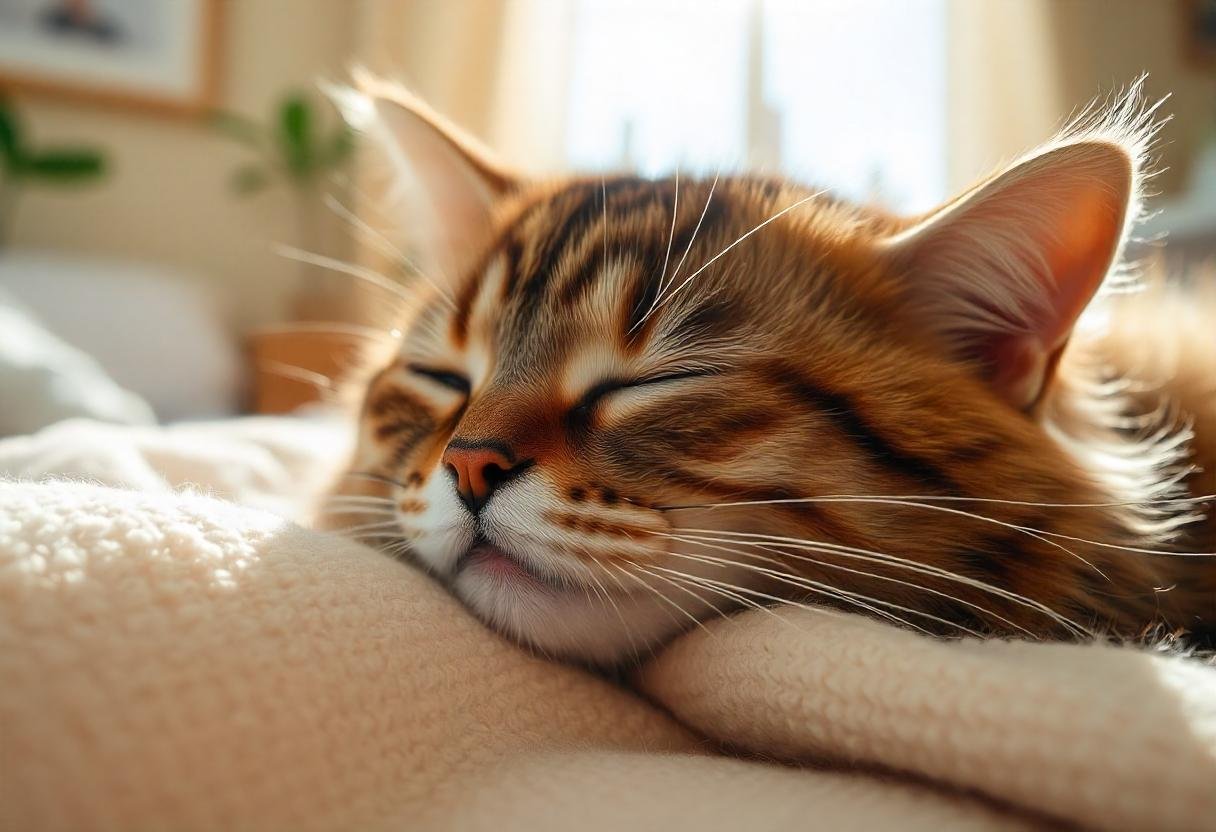Every cat owner knows their furry friend can be full of surprises, and sometimes those surprises involve a little bit of sniffling and sneezing. But when does a simple cat sneezing become a cause for concern?
What is Cat Sneezing?
Cat sneezing, just like in humans, is a reflex action that helps to clear the nasal passages of irritants, such as dust, pollen, or allergens.
Why is Cat Sneezing a Concern?
While an occasional sneeze is usually harmless, frequent or persistent sneezing in cats can be a sign of an underlying medical condition that requires veterinary attention.
Common Causes of Cat Sneezing
Here are some common reasons why a cat might be sneezing:
- Allergies: Allergies to pollen, dust mites, mold, or other environmental allergens can cause sneezing, runny nose, and eye irritation.
- Upper Respiratory Infections (URIs): URIs, commonly caused by viruses or bacteria, can cause inflammation and swelling of the nasal passages, leading to sneezing, runny nose, and eye discharge.
- Feline Herpesvirus (FHV): FHV is a common virus that can cause chronic or recurrent upper respiratory infections in cats, including sneezing. It can also lead to conjunctivitis, eye discharge, and ulcers on the nose and mouth.
- Feline Calicivirus (FCV): FCV is another common virus that can cause upper respiratory infections, including sneezing.
- Nasal Polyps: Nasal polyps are growths in the nasal passages that can block airflow and cause sneezing.
- Dental Disease: Dental disease can cause inflammation and swelling in the nasal passages, leading to sneezing and other symptoms.
- Foreign Objects: Small objects, such as grass awns or pieces of food, can become lodged in the nose, causing inflammation and swelling, leading to sneezing.
- Tumors: Tumors in the nasal passages can also cause swelling and block airflow, leading to sneezing.
- Trauma: Injuries to the nose, such as a bite or a scratch, can cause inflammation and swelling, leading to sneezing.
- Dust and Irritants: Dust, smoke, and other environmental irritants can also trigger sneezing.
Symptoms of Cat Sneezing
Cat sneezing can vary in frequency, intensity, and sound. Here are some common signs of cat sneezing:
- Sneezing Sound: The sneezing sound can vary, from a soft “ah-choo” to a loud, forceful “achoo.”
- Discharge: Discharge from the nose can be clear, white, yellow, or green, depending on the cause of the sneezing.
- Eye Discharge: The cat might have watery or cloudy eye discharge.
- Conjunctivitis: The conjunctiva (the membrane that lines the eyelids) might be inflamed, causing redness and swelling.
- Labored Breathing: The cat might have difficulty breathing, making a whistling or rattling sound.
- Snoring: The cat might snore more loudly than usual.
- Nosebleeds: In some cases, the cat might have nosebleeds.
- Facial Pain: The cat might rub their face or paw at their nose, showing signs of pain.
- Loss of Appetite: The cat might have a decreased appetite due to pain or discomfort.
- Lethargy: The cat might become lethargic and inactive.
A Case Study: Whiskers’ Sneezing Fits
Whiskers, a 5-year-old Maine Coon, started sneezing frequently. His owner, David, also noticed that Whiskers’ nose seemed to be swollen. “He was normally so playful,” David says. “But he was quieter than usual, and he kept sneezing.”
David took Whiskers to the vet, who performed a physical exam and examined Whiskers’ nose. The veterinarian suspected that Whiskers had an upper respiratory infection. “Whiskers’ nose is inflamed,” the veterinarian explained. “It’s likely a viral infection.”
Whiskers was prescribed antibiotics to treat a possible secondary bacterial infection, and his sneezing resolved after a few days.
Diagnosing Cat Sneezing
Diagnosing the cause of sneezing in cats requires a thorough examination by a veterinarian. They will perform a physical exam, examine your cat’s nose and respiratory system, and often recommend some additional testing.
- Physical Examination: The veterinarian will assess your cat’s overall health, including their weight, body condition, and any signs of illness. They will check your cat’s temperature, pulse, and respiration, and they will examine their eyes, ears, nose, teeth, and gums. They will also feel your cat’s lymph nodes for any abnormalities.
- Bloodwork: Blood tests can help rule out a variety of medical conditions, such as feline leukemia virus (FeLV), feline immunodeficiency virus (FIV), or other infections.
- Radiographs (X-rays): X-rays can help to identify any abnormalities in the nasal passages, such as tumors or foreign objects.
- Endoscopy: In some cases, your veterinarian might recommend an endoscopy, a procedure where a thin, flexible tube with a camera is inserted into the nose to examine the lining for signs of inflammation or other problems.
Treating Cat Sneezing
Treatment for sneezing in cats depends on the underlying cause.
- Allergies: For allergies, your veterinarian may recommend:
- Environmental Control: Minimize exposure to the offending allergen.
- Antihistamines: Antihistamines can help reduce itching, inflammation, and sneezing.
- Corticosteroids: Corticosteroids are potent anti-inflammatory medications that can help reduce itching, inflammation, and sneezing, but they can have side effects.
- Immunomodulators: Immunomodulators can help suppress the immune system’s response to allergens, reducing allergy symptoms.
- Upper Respiratory Infections (URIs): For URIs, your veterinarian may prescribe antibiotics to treat bacterial infections or antiviral medications for viral infections.
- Feline Herpesvirus (FHV) and Feline Calicivirus (FCV): There is no cure for FHV or FCV, but your veterinarian can prescribe medications to manage symptoms, such as:
- Antibiotics: To treat secondary bacterial infections.
- Anti-Inflammatory Medications: To reduce inflammation and swelling.
- Nasal Polyps: Nasal polyps can be surgically removed.
- Dental Disease: For dental disease, your veterinarian may recommend a dental cleaning or extraction of any loose teeth.
- Foreign Objects: If a foreign object is lodged in the nose, your veterinarian may need to perform a surgical procedure to remove it.
- Tumors: Treatment for nasal tumors might involve surgery to remove the tumor, radiation therapy to shrink the tumor, or chemotherapy to kill cancer cells.
- Trauma: Treatment for injuries to the nose might involve medication to reduce swelling and pain, antibiotics to prevent infection, or surgery to repair the damage.
A Case Study: Whiskers’ URI Recovery
Whiskers, the Maine Coon with an upper respiratory infection, responded well to treatment. The veterinarian prescribed him antibiotics, and David followed the veterinarian’s instructions for providing him with supportive care. “Whiskers felt much better after a few days on the antibiotics,” David says. “He was back to his normal self, happily playing and purring.”
Tips for Caring for a Cat Who is Sneezing
- Monitor Your Cat’s Behavior: Pay close attention to your cat’s behavior, especially if they’re having difficulty breathing or showing signs of discomfort.
- Provide Fresh Water: Make sure your cat has access to fresh water at all times.
- Consult a Veterinarian Immediately: If you notice any signs of swelling, redness, discharge, or other concerning symptoms in your cat’s nose, consult your veterinarian immediately. These could be signs of a serious medical condition that requires treatment.
Conclusion
While sneezing in cats can sometimes be a normal behavior, it’s important to be aware of the possible underlying causes. If your cat is sneezing excessively, or if they’re exhibiting any other unusual symptoms, it’s always a good idea to consult your veterinarian. By seeking professional advice and taking appropriate steps, you can help your cat live a healthy and happy life.









